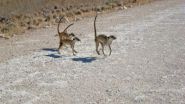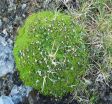(Press-News.org) The results are significant because they can help to improve our understanding of medical conditions, such as thrombosis, aneurysms and arteriosclerosis. The research team is publishing its results in Physical Review Letters and the American Physical Society has highlighted the work on its Physics website, placing it on the Focus List of important physics news.
Blood flows differently than water. Anyone who has ever cut themselves knows that blood flows viscously and rather erratically. The similarity between blood and ketchup is something not only filmmakers are aware of. Experts refer to these materials as "non-Newtonian fluids," of which ketchup and blood are prime examples. These fluids have flow properties that change depending on conditions, with some becoming more viscous, while others become less viscous. Blood (like ketchup) is a "shear thinning fluid" that becomes less viscous with increasing pressure and it is this that allows blood to flow into the narrowest of capillaries. The flow properties of water are, in contrast, essentially constant.
Up until now it has been assumed that the special flow characteristics exhibited by blood were mainly due to the presence of the red blood cells, which account for about 45 percent of the blood's volume. Blood plasma was generally regarded simply as a spectator that played no active role. For decades, researchers have assumed that blood plasma flows like water. After all, plasma, the liquid in which the blood cells are suspended, consists to 92 percent of water. But results from researchers at Saarland University and at the University of Pennsylvania have now shown that plasma is a very special fluid that plays a crucial part in determining how blood flows. The results demonstrate that blood plasma is itself a non-Newtonian fluid.
According to the study's findings, the complex flow behavior of blood plasma could play a crucial role with respect to vascular wall deposits, aneurysms or blood clots. The results from this research may well help to improve computer simulations of this kind of pathological process.
The research team around experimental physicist Christian Wagner and engineer Paulo E. Arratia have studied the flow dynamics of blood experimentally. The work at Saarland University involved experiments in which the blood plasma was allowed to form drops inside a specially built apparatus equipped with high-speed cameras fitted with high-resolution microscope lenses to analyze drop formation. "Our experiments showed that the blood plasma forms threads, that is, it exhibits an extensional viscosity, which is something we do not observe in water," explained Professor Wagner. The plasma shows "viscoelastic" properties, which means that it exhibits both viscous and elastic behavior when deformed, forming threads that are typical of non-Newtonian fluids.
The studies by Professor Arratia and his team at the University of Pennsylvania involved a microfluidic approach in which they developed a model of a microvascular system in order to study the flow properties of blood plasma. Their measurements showed that blood plasma exhibits a flow behavior different to that of water and that plasma can demonstrate a substantially higher flow resistance. "An important part of our study was developing microfluidic instruments sensitive enough to pick up the small differences in viscosity that are the signature of non-Newtonian fluids," explained Professor Arratia.
Experiments performed by Professor Wagner's team in Saarbrücken also showed that blood plasma influences the creation of vortices in flowing blood. These vortices may facilitate the formation of deposits on blood vessel walls which could influence blood clot formation. In one of their experiments, the research team let plasma flow through a narrow channel of the kind found in stenotic (constricted) arteries or in a stent (a medical implant inserted into constricted blood vessels). The vortical structures were detected at the end, but also at the entrance, of the narrow channel and their formation is a direct result of the viscoelastic flow properties of blood plasma.
INFORMATION:
The research at Saarland University was performed within the Research Training Group "Structure Formation and Transport in Complex Systems" funded by the German Research Foundation (DFG). The research at the University of Pennsylvania was supported by the US National Science Foundation - CBET- 0932449.
VIDEO:
This image is from the article, Rheology of human blood plasma: Viscoelastic versus Newtonian behavior.
Click here for more information.
Original publication:
M. Brust, C. Schaefer, R. Doerr, L. Pan, M. Garcia, P. E. Arratia, and C. Wagner (2013):
"Rheology of human blood plasma: Viscoelastic versus Newtonian behavior",
Phys. Rev. Lett., 110, 078305 (2013)
DOI: 10.1103/PhysRevLett.110.078305
http://link.aps.org/doi/10.1103/PhysRevLett.110.078305
Physics: Focus: http://physics.aps.org/articles/v6/18 (video)
Contact:
Professor Dr. Christian Wagner
Department of Experimental Physics, Saarland University
Tel.: 0049 (0)681 302-3003 or -2416; E-mail: c.wagner@mx.uni-saarland.de
http://agwagner.physik.uni-saarland.de/
Professor Paulo E. Arratia
Department of Mechanical Engineering and Applied Mechanics, University of Pennsylvania
Tel.: 001 215 746-2174; E-mail: parratia@seas.upenn.edu
www.seas.upenn.edu/~parratia
Press photographs are available at www.uni-saarland.de/pressefotos and can be used at no charge. Please read and comply with the conditions of use.
Note for radio journalists: Studio-quality telephone interviews can be conducted with researchers at Saarland University using broadcast audio IP codec technology. Interview requests should be addressed to the university's Press and Public Relations Office (+49 (0)681 302-2601).
Blood is thicker than water -- and blood plasma is, too
2013-02-19
ELSE PRESS RELEASES FROM THIS DATE:
Researchers in Manchester find genetic key to preventing spine tumors
2013-02-19
Genetic medicine experts from Manchester Biomedical Research Centre at Saint Mary's Hospital and The University of Manchester have identified a new gene responsible for causing an inherited form of tumour, known as spinal meningioma.
Professor Richard Marias, Director of the Paterson Institute
Meningiomas are the commonest form of tumour affecting the brain and spine. Usually meningiomas can be removed by surgery and do not recur. Occasionally people can develop more than one meningioma or many members of the same family can be affected.
A team led by Dr Miriam Smith, ...
Subordinate animals as guinea pigs
2013-02-19
In their environment, wild animals are exposed to countless threats, be they predators, diseases or natural obstacles to get over, such as gorges or rivers. In the course of evolution, they have developed specific behavioural responses to allow them to deal with these risks. In recent times, numerous man-made threats have been added to the naturally-existing ones, such as dangerous roads to cross. On the evolutionary time scale, it is excluded that the animals have evolved a whole new repertoire of adaptive responses to these risks. Simon Townsend is a behavioural biologist ...
Reduced sea ice disturbs balance of greenhouse gases
2013-02-19
The widespread reduction in Arctic sea ice is causing significant changes to the balance of greenhouse gases in the atmosphere. This is shown in a new study conducted by researchers from Lund University in Sweden, among others.
According to the study, the melting of sea ice in the Arctic has a tangible impact on the balance of greenhouse gases in this region, both in terms of uptake and release. The researchers have studied the greenhouse gases carbon dioxide and methane both in the tundra and in the Arctic Ocean.
"Changes in the balance of greenhouse gases can have ...
The criteria for weight-loss surgery need to be changed
2013-02-19
Weight-loss surgery is currently only offered to patients who exceed a certain BMI. However, surgical intervention could improve the health of many more people. This is shown by the Swedish Obese Subjects study carried out at the Sahlgrenska Academy, University of Gothenburg, Sweden, involving 104 patients who were operated on despite their BMI being "too low". As a result, the risk of developing diabetes was reduced by 67 percent.
In order to meet the current selection criteria for weight-loss surgery, Swedish patients must have a body mass index (BMI) above 40 for ...
Cushion plants help other plants survive
2013-02-19
Alpine cushion plants help other plants in harsh mountain environments to survive. This is shown by new research involving researchers from the University of Gothenburg, the results of which are now being publishing in the highly respected journal Ecology Letters.
Cushion plants are a type of plant found in areas such as Arctic environments, and are characterised by their distinctive, round, cushion-like shape.
A new study highlights the strong interaction between cushion plants and other plants in the most severe of mountain environments.
"Cushion plants create additional ...
New projections of 'uneven' global sea-level rise
2013-02-19
Sophisticated computer modelling has shown how sea-level rise over the coming century could affect some regions far more than others. The model shows that parts of the Pacific will see the highest rates of rise while some polar regions will actually experience falls in relative sea levels due to the ways sea, land and ice interact globally.
Reporting in the journal Geophysical Research Letters researchers have looked ahead to the year 2100 to show how ice loss will continue to add to rising sea levels. Scientists have known for some time that sea level rise around the ...
New insight into dogs fear responses to noise
2013-02-19
A study has gained new insight into domestic dogs' fear responses to noises. The behavioural response by dogs to noises can be extreme in nature, distressing for owners and a welfare issue for dogs.
The research by academics from the School of Veterinary Sciences at the University of Bristol, and funded by the RSPCA, is published in Applied Animal Behaviour Science. The study provides an important insight into dogs' fear of noises, and could improve our understanding of behavioural signs of fear or anxiety.
In the study two approaches were taken to investigate the ...
Molecules generated that can halt metastasis of colon cancer
2013-02-19
A Basque research consortium has managed to halt the progress of colon cancer and its metastasis in the liver in an experimental model with mice. This advance, that may open a new path for the future treatment of such pathologies, has been achieved by creating molecules which interfere with the adhesion of tumour cells to other cells of the organism. In this way, the molecules halt both the growth of the tumour and the dissemination of the tumour to and its proliferation in other organs.
The research, published in the prestigious North American Journal of Medicinal Chemistry, ...
CWRU study examines family struggles with anger and forgiveness when relative is dying
2013-02-19
Watching a loved one die tests some family members' relationships with God or the higher being of one's faith. And the spiritual anger and resentment grow with the level of pain and suffering their family member endures, according to researchers at Case Western Reserve University.
Psychologist Julie Exline and palliative care advanced practice nurse Maryjo Prince-Paul surveyed 147 family members with a hospice patient under home care.
More than four of every 10 respondents reported at least some level of anger with God, a major source of which was watching a loved ...
New discoveries linking gut bacteria with cholesterol metabolism give hope for the future
2013-02-19
Researchers at the Sahlgrenska Academy, University of Gothenburg, Sweden, show that cholesterol metabolism is regulated by bacteria in the small intestine. These findings may be important for the development of new drugs for cardiovascular disease.
It is well established that cholesterol is the major risk factor for cardiovascular disease. Cholesterol – which is mainly synthesized in the body but also obtained from dietary sources – is converted to bile acids in the liver, which are then secreted into the intestine and either removed from the body or recycled back to ...


